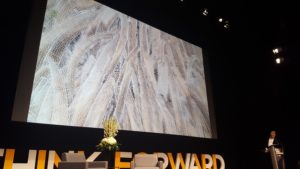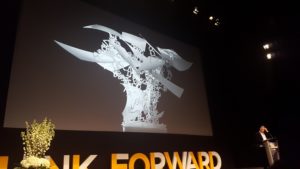 Oh, Canada! Yesterday at the TIFF (Toronto International Film Festival) Bell Lightbox, Think2Thing and Ryerson University brought the second Be3D conference together, centered around one idea: “Think Forward.” With focus on 3D technologies and their impact on especially the arts in Canada, Be3D looked to not only 3D printing, but also virtual reality and augmented reality. While lately we’ve heard a lot about 3D technologies around the world, from Europe to the UAE to Iran, Canada often politely allows other industries to take the limelight. Be3D is a sign that that’s about to change, as Canada — and especially Toronto — is seeking to become a true hub of technology.
Oh, Canada! Yesterday at the TIFF (Toronto International Film Festival) Bell Lightbox, Think2Thing and Ryerson University brought the second Be3D conference together, centered around one idea: “Think Forward.” With focus on 3D technologies and their impact on especially the arts in Canada, Be3D looked to not only 3D printing, but also virtual reality and augmented reality. While lately we’ve heard a lot about 3D technologies around the world, from Europe to the UAE to Iran, Canada often politely allows other industries to take the limelight. Be3D is a sign that that’s about to change, as Canada — and especially Toronto — is seeking to become a true hub of technology.
Seven speakers touched on various ways that 3D technologies are coming into play across a variety of applications. As the TIFF Bell Lightbox is located in the heart of Toronto’s entertainment district, we especially heard a lot about that industry, with the day’s engaging speakers focusing in on the importance of technology in storytelling.
 Dr. Barry Sandrew took to the stage first, bringing with him an extensive background in the film industry, as he applied lessons gained from decades working with visual effects — he’s colorized about 350 feature films over the course of his career — to the future potential of augmented reality and virtual reality. Acceptance of these 3D technologies in entertainment can draw direct parallels to what the film industry saw when originally black and white movies were colorized; some audiences love it, some prefer to be less engaged in a story and would rather be passively involved in the experience, which becomes difficult when additional effects draw the viewer deeply into a story. Thomas Wallner underscored this point, showing a video of people watching a VR film, in which it was instinctual for them to wave when a person appeared in their field of view.
Dr. Barry Sandrew took to the stage first, bringing with him an extensive background in the film industry, as he applied lessons gained from decades working with visual effects — he’s colorized about 350 feature films over the course of his career — to the future potential of augmented reality and virtual reality. Acceptance of these 3D technologies in entertainment can draw direct parallels to what the film industry saw when originally black and white movies were colorized; some audiences love it, some prefer to be less engaged in a story and would rather be passively involved in the experience, which becomes difficult when additional effects draw the viewer deeply into a story. Thomas Wallner underscored this point, showing a video of people watching a VR film, in which it was instinctual for them to wave when a person appeared in their field of view.
“From a cognitive point of view, I find that very interesting, you see a person and you wave,” Wallner said. “Our brain does not care about reality, it cares about stories.”
 Looking to the way the human brain handles reality — the real one, as well as virtual and augmented varieties — Maryam Nabavi also spoke to the convergence of technology in experience, as “the virtual and physical worlds are getting closer.” Nabavi discussed the Phygitization Revolution, in which we are embedding intelligence into production tools, engaging the senses in a deeper and more immersive way along the experiences we’re creating. She presented four macro changes here regarding how our perception of reality is changing:
Looking to the way the human brain handles reality — the real one, as well as virtual and augmented varieties — Maryam Nabavi also spoke to the convergence of technology in experience, as “the virtual and physical worlds are getting closer.” Nabavi discussed the Phygitization Revolution, in which we are embedding intelligence into production tools, engaging the senses in a deeper and more immersive way along the experiences we’re creating. She presented four macro changes here regarding how our perception of reality is changing:
- Deep Immersion — bringing more senses into the VR experience, such as infusing smell, which is strongly tied to memory (in a technological addition first developed for the porn industry), and turning the body into a haptic sensor to add in physical sensation to more closely tie in simulations
- Shaping Real World Behavior — the brain doesn’t differentiate between what it sees and what it imagines; the brain doesn’t care about difference between what we see and what we imagine
- Radical Atoms — digital information has physical manifestation so we can interact directly with it; liquid interfaces (MIT Media Lab’s X-print ; transformable garment); adaptive materials as actuators
- Democratization of Design — as AR is becoming embedded in design/production tools; generative design; Ai Build & other companies demonstrating how AI can design, optimize structural strength “in a much more elegant and beautiful way”
Edward Burtynsky touched on several interesting case studies of 3D technologies put to use for storytellers, from artists benefiting from an innovation fund to 3D printed tortoise shells to fool predatory ravens to a 3D printed replica of a historical ship’s bell, as well as art created by Think2Thing co-founder David Didur that would not have been possible without 3D printing and a photogrammetry project to create a 3D reconstruction of a giant pile of tusks prior to their being burned. Jesse Hirsch’s presentation started the audience laughing as he proclaimed that, “We as a society are FUCT — that is, fully under control of technology.” He discussed the hold that tech has on each of us today, as well as Toronto’s rising place in the tech scene and how that position benefits from an open source ideology that ties in closely with Canadian culture.
“We forget one of those things that makes Canada Canada — that sharing ethic,” Hirsch said. “Our healthcare has always been free, if not accessible; our education has always been free, if not accessible. Should our technology not also be accessible?“
From robots following people in a more Hanoi-like Toronto of the future in Greg Lynn’s presentation to a look at funding for creatives in Canada in a talk from Simon Brault, the day’s discussions were certainly thinking forward. We’ll be sharing more of their thoughts over the coming days to take a closer look at some of the specifics, so stay tuned for more details from these thought leaders on how, for example, innovation supplements creativity.
 On the agenda at the Be3D Think Forward conference were:
On the agenda at the Be3D Think Forward conference were:
- Richard Crouse, CTV film critic, the emcee for the day
- Barry Sandrew, visual effects pioneer and founder of Legend3D
- “Lessons Learned from Colorization and 3D Conversion Applied to Virtual and Augmented Reality“
- Greg Lynn, architect and Microsoft HoloLens partner
- “Design and Construction are Becoming Less and Less Mediated by Translation into 2D Documents“
- Thomas Wallner, writer, director and Founder/CEO of DEEP Inc.
- “VR and Storytelling: Aesthetic and philosophical challenges of using VR in a cinematic context“
- Maryam Nabavi, design strategist and VP, IC/things at Idea Couture
- “Tangible Media: How virtual and physical worlds are becoming one“
- Edward Burtynsky, filmmaker and photographer
- “How Artists, Designers, and Storytellers are Working with AR and VR Technologies“
- Jesse Hirsch, researcher and futurist
- “Technology, Policy and Innovation: Why Toronto could lead the 3D revolution“
- Simon Brault, Director and CEO of Canada Council for the Arts
- “Funding the Arts in a Digital Society“
Subscribe to Our Email Newsletter
Stay up-to-date on all the latest news from the 3D printing industry and receive information and offers from third party vendors.
You May Also Like
Gorilla Sports GE’s First 3D Printed Titanium Cast
How do you help a gorilla with a broken arm? Sounds like the start of a bad joke a zookeeper might tell, but it’s an actual dilemma recently faced by...
Nylon 3D Printed Parts Made More Functional with Coatings & Colors
Parts 3D printed from polyamide (PA, Nylon) 12 using powder bed fusion (PBF) are a mainstay in the additive manufacturing (AM) industry. While post-finishing processes have improved the porosity of...
$25M to Back Sintavia’s Largest Expansion of Metal 3D Printing Capacity Since 2019
Sintavia, the digital manufacturing company specializing in mission-critical parts for strategic sectors, announced a $25 million investment to increase its production capacity, the largest expansion to its operations since 2019....
Velo3D Initiates Public Offering in a Bid to Strengthen Financial Foundations and Drive Future Growth
Velo3D (NYSE: VLD) has been among a number of publicly traded 3D printing firms that have attempted to weather the current macroeconomic climate. After posting a challenging financial report for 2023,...


































